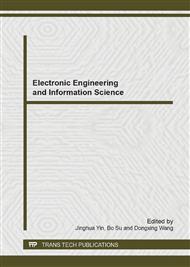p.463
p.469
p.474
p.478
p.482
p.486
p.490
p.494
p.501
Effects of Energy Harvesting Rate on Lifetime and Throughput Capacity in Wireless Sensor Networks
Abstract:
Energy-harvesting Wireless sensor networks have gained more and more attention in recent years. For traditional battery-powered WSNs, the effect of transmission power on the throughput capacity and the lifetime have been well studied. The throughput capacity of WSNs is defined usually as the largest common throughput that can be provided to each source-sink pair nodes. Researches showed that high transmission power increases the throughput capacity of WSNs However, the high transmission power leads to a high energy consumption, thus the tradeoffs between the capacity and the lifetime under different transmission power have been analyzed.
Info:
Periodical:
Pages:
482-485
Citation:
Online since:
July 2014
Authors:
Price:
Сopyright:
© 2014 Trans Tech Publications Ltd. All Rights Reserved
Share:
Citation:


